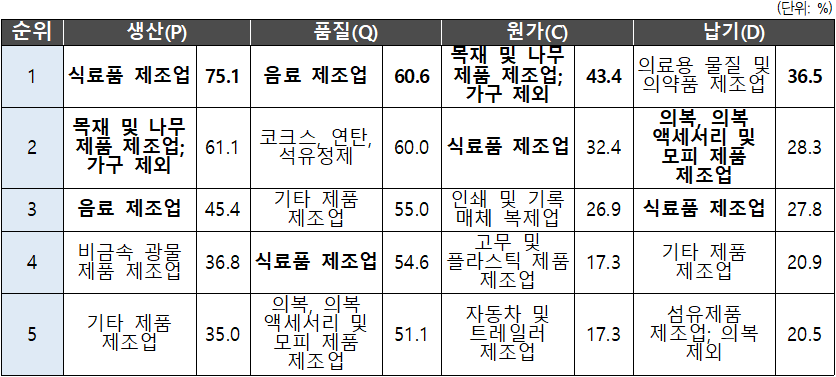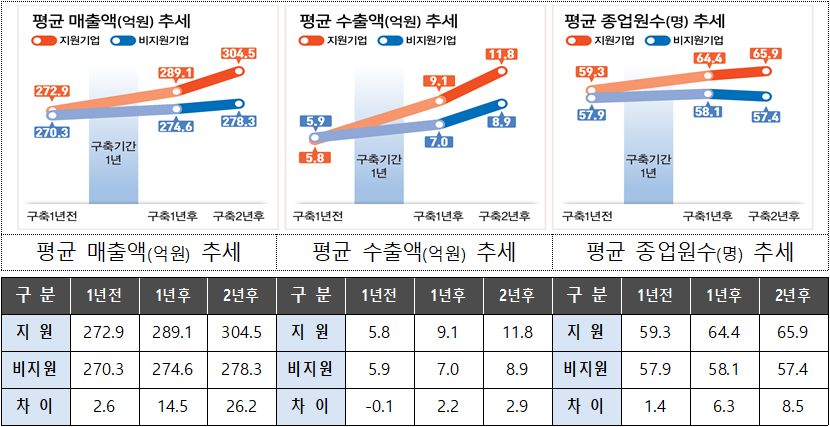중소벤처기업부가 스마트팩토리 보급사업 성과분석 결과를 발표했다. 발표에 따르면, 스마트팩토리를 도입한 중소기업은 평균적으로 생산성 30% 증가, 품질 43.5% 향상, 원가 15.9% 감소, 납기 준수율 15.5% 증가하는 등 경쟁력이 높아졌다. 또한, 매출이 증가하면서 고용도 평균 3명이 증가하였고, 산업재해는 18.3% 감소하는 등 양질의 일자리를 창출하는 것으로 나타났다.
| 소규모 기업 공정·경영개선 성과 대체로 높아
| Lv.1 수준 기업, 생산성 향상 효과 가장 좋아
| Lv.4 수준 기업, 품질-원가-납기 개선 효과
중소벤처기업부는 ‘스마트팩토리 보급사업 성과분석’ 결과 발표를 통해 “스마트팩토리를 도입한 중소기업은 평균적으로 생산성 30% 증가, 품질 43.5% 향상, 원가 15.9% 감소, 납기 준수율 15.5% 증가하는 등 경쟁력이 높아졌다”고 23일 밝혔다.

스마트팩토리 도입 중소기업, 평균적으로 생산성 30% 향상
또한 “매출이 증가(7.7%)하면서 고용도 평균 3명이 증가하였고, 산업재해는 18.3% 감소하는 등 양질의 일자리를 창출하는 것으로 나타났다”고 발표했다.
조사는 2014년부터 2017년까지 스마트팩토리를 도입한 5,003개 기업을 대상으로 진행됐으며, 중기부는 이번 조사 결과를 향후 스마트팩토리 정책수립 기초자료로 활용할 예정이다.
이번 조사는 특히 기존에 수행했던 설문조사 방식에서 벗어나 기업데이터․고용노동부 자료 등 행정 데이터를 활용하고, 스마트팩토리 미 도입 기업 중 유사 조건을 가진 기업과 비교분석(Propensity Score Matching; PSM)을 실시했다.
스마트팩토리 도입 전후 성과 분석
소규모 기업이 공정개선(생산성 향상 등) 및 경영개선(고용․매출 증가율 등) 성과가 대체로 높은 것으로 나타났다.
공정개선 효과의 경우 종업원 수 10인 미만 기업의 경우 생산성이 39.0% 증가하여 평균(30.0%) 개선효과를 크게 상회했고, 품질․원가․납기 개선효과도 가장 높은 것으로 나타났다.
매출액 기준으로 분석한 결과도 매출액 10억 원 미만 기업은 원가가 31.2% 감소하여 평균(15.9%)보다 2배 정도의 개선을 시현하였고, 생산․품질․납기 개선효과도 가장 높았다.

기업 규모별 공정개선 성과 비교
경영개선 효과는 종업원 수 10인 미만 기업이 84.9%의 고용증가를 시현하여 가장 많은 일자리를 창출하였고, 산업재해율 감소 효과도 가장 높았다.
매출액 기준으로도 매출액 10억 원 미만 기업은 매출 증가율이 202.3%에 달해 전체 평균 7.7%를 크게 앞질렀고, 고용증가율도 1위(33.1%)를 기록해 개선효과가 높은 것으로 나타났다.

기업 규모별 경영개선 성과 비교
업종별 분석결과는 소규모 기업 비중이 높은 식료품 제조업, 목재 제조업 등이 성과가 높은 것으로 나타났다.

공정개선 성과 상위 5개 업종
스마트팩토리 도입 수준별로는 도입 기업의 대부분(78.7%)을 차지하는 Level 1~2(기초) 수준 기업이 생산성 향상 효과가 가장 높게(31.2%) 나타났다.

구축수준별 경영개선 성과
다만, 품질․원가․납기 개선효과는 Level 4(중간2) 수준기업이 가장 높았다. Level 4 수준 기업은 5,003개 기업 중 약 1% 수준이다.
스마트팩토리 도입 여부에 따른 성과 비교
스마트팩토리 도입을 완료한 기업과 유사 조건의 미 도입 기업에 대한 비교분석을 실시한 결과 스마트팩토리 도입 기업이 매출액․수출액․고용에서 성과가 더 높았고, 동 격차는 기간이 경과할수록 심화되는 것으로 나타났다.

도입기업과 유사 조건의 미도입기업 간 PSM 분석 결과
중기부 김영태 기술혁신정책관은 “이번 조사결과를 통해 정부 8대 혁신성장 선도사업 중 하나인 스마트팩토리 보급사업의 높은 성과를 다시 한 번 확인할 수 있었다”고 말했다.
이어 “상대적으로 개선 여지가 많은 소규모 기업이 스마트팩토리 도입 성과가 상대적으로 높게 나타난다는 점을 고려하여 소규모 기업에 대한 스마트팩토리 저변확대와 함께 고도화된 공장을 구축하는 투트랙 전략을 펼칠 필요가 있다”고 밝혔다.
중기부는 성과가 높은 스마트팩토리를 조기에 확산하기 위해 올해 5월부터 전국 19개 제조혁신센터에서 지역별 성과보고회를 개최할 계획이다.





